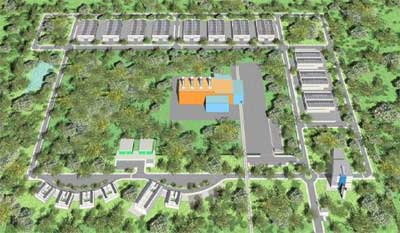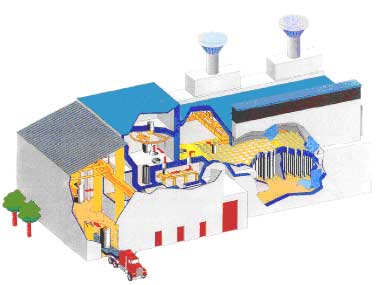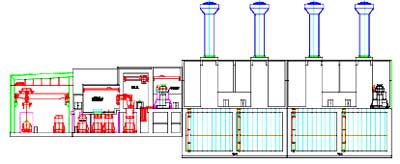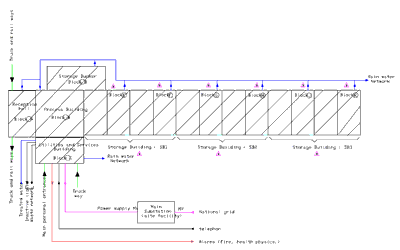
ATC: The Centralised Storage Facility for Spain’s spent nuclear fuel and high-level radioactive waste
By Pablo Zuloaga
ENRESA
Introduction
Spain has eight power reactors in operation and two power reactors closed down and at different stages of decommissioning.
The Industry Commission of the Spanish Parliament unanimously recommended to the Government, in 2004, the development of a centralised storage facility for Spanish nuclear spent fuel (NSF) and high-level radioactive waste. Finally, the Government, which is responsible for the definition of radioactive waste management policy, stated in the 6th Radioactive Waste General Plan1 of 2006 that the construction of the Centralised Storage Facility (“ATC” in Spanish) was a priority.
In 2006, a Commission presided over by the Secretary of State for Energy was set up to define the criteria and to supervise the site selection process on a transparent, democratic and participative basis. In the same year an information campaign directed to all the municipalities in the country was carried out. This campaign included publicity in all the newspapers, publication of information on the web site of the Inter-ministerial Commission and the answering of questions from the municipal councils and general public, etc.
In December 20092, the Spanish Secretary of State for Energy launched a public call for candidate municipalities to host the “Centralised Interim Storage Facility” for nuclear spent fuel and high-level radioactive waste.
The planned facility is designed to receive and store for decades to come all the spent fuel resulting from Spanish nuclear power reactors (i.e. some 6,700 tonnes of heavy metal) and the high-level vitrified waste and long-lived intermediate-level waste generated from the reprocessing of Spanish fuel abroad. It will also receive and store intermediate-level radioactive waste from nuclear power plants being decommissioned (those with activity levels higher than the El Cabril LILW disposal facility acceptance criteria). This period of time is judged sufficient to allow for the technical and social developments that will help define strategies for longer-term management options.
ENRESA is the Spanish Inter-ministerial organisation responsible for radioactive waste and nuclear spent fuel management and for the decommissioning of nuclear installations. It supports the Commission by providing the required technical studies and information for the different stakeholders. It is also responsible for the design, construction and operation of such a facility and is, therefore, the implementer of the described policy. Furthermore, ENRESA carries out studies on long-term solutions and management options to assist the Government with its decision-making.
The Technology Park and the Centralised Storage Facility
The project consists of three main elements (figure 1):

Figure 1: The ATC Technology Park and SNF & HLW Centralised Storage Facility
This threefold approach will assist local and regional development, stimulate business opportunities in the area, provide an opportunity to enhance Spanish research into how nuclear spent fuel and high-level waste behave and support further management decisions.
The total surface area of the park will be around 30 hectares.
The Centralised Storage Facility
The facility has been designed to meet the technical criteria of 10CFR723, with envelope site characteristics. Specifically it has been designed to:
-
Maintain sub-criticality
-
Maintain confinement of radioactive material
-
Ensure that radiation rates and doses for workers and public do not exceed acceptable levels and remain ALARA
-
Maintain retrievability
-
Provide for heat removal, as required, to meet the above-mentioned safety functions
Sub-criticality criteria are met through the geometrical arrangement inside the canisters. Confinement criteria are met thanks to a double confinement system. The NSF itself is not considered as a confinement barrier, the two barriers being the canister and the storage well. Radiation criteria are met thanks to 1.8 m thick walls. A natural through draft of fresh air provides the cooling, which maintains temperatures below acceptable levels. The structural design and siting criteria provide protection against natural or man-made risks.
The main parts of the Centralised Storage Facility (figure 2) are:

Figure 2: The conceptual design of ATC storage vaults
The technology selected for SNF and HLW storage is dry storage in canisters, placed in dry wells inside storage vaults. A cross-section and general layout of this facility can be seen in figures 3 and 4 below.

Figure 3: A cross section of the ATC facility’s main buildings

Figure 4: General Layout of ATC facility
In 2004, ENRESA presented a generic design of the ATC facility and its safety analysis report to the Safety Authority, the “Consejo de Seguridad Nuclear (CSN),” which judged the generic design “favourable4 “in June 2006.
The reception area is designed to receive transport by road or train, and for moving the transport casks to a vertical position and transferring them to the process area.
Inside the process area the opening of the transport casks, the connecting of the casks to the unloading cells and the unloading of the fuel assemblies or radioactive waste packages inside the two manipulation cells takes place. One of the unloading places is intended for encapsulated waste that does not need to be transferred to a canister. The second line is intended for spent fuel that needs to be placed inside a canister. Once a canister is filled with spent fuel, the lid is automatically welded, the vacuum is raised and the canister backfilled with helium before final sealing.
The canisters are then moved to the storage vaults. The canister with spent fuel or vitrified waste is placed inside the drywell, which is backfilled with nitrogen to have an inert environment around the canister, thereby allowing for potential helium leak detection from the canisters. Two spent fuel canisters or seven vitrified waste canisters can be stacked inside each drywell.
The drywell’s wall is a double one, providing a cooling air circulation path for residual heat extraction by natural draft, which is provided by 46m high stacks.
There will be twelve storage vaults, one of which will provide redundant storage capacity - if required given the long storage periods considered. One storage building houses four vaults. In this way there will be three storage buildings constructed sequentially, according to operational needs.
The facility is completed with a storage module or bunker providing room for medium activity waste coming from the reprocessing of fuel from the Vandellos I NPP. There is some internal debate about the need for an additional storage building or the convenience of being able to enlarge this storage module to accommodate larger amounts of intermediate activity waste (or low-level GTCC) from reactor decommissioning and to provide buffer storage for spent fuel casks - especially for those previously encapsulated in double-sealed canisters.
The Technology Centre associated with ATC
The building of a Technology Park is planned to complement the Centralised Storage Facility. Its main laboratory will be a research laboratory for spent fuel and high-level waste. It will have two nuclear laboratories, the spent fuel laboratory already mentioned, and a low-level waste laboratory. Their original basic design is under revision for integration into the Centralised Storage facility. This will make the transfer of radioactive material easier and enable the building and licensing of a single nuclear facility.
Other laboratories foreseen in the Technology Park are a materials behaviour laboratory, a chemical and environmental laboratory and a robotics and industrial pilot plant laboratory.
The Business Park
The project includes an industrial park that will offer synergetic support for the ATC facility and encourage regional development. This Business Park will have general offices providing services to new companies and a number of industrial buildings.
Site selection
As mentioned in the introduction, the site selection is based on a voluntary procedure that was launched in December 2009. A number of local authorities, after receiving approval from their Municipal Councils, volunteered to host the ATC facility. The second step of the process was the analysis of the application of exclusion criteria defined in the call for candidates. These criteria related, mainly, to the protection of environmental and cultural heritage. A preliminary definition of areas where the proposed land for siting the ATC facility was deemed unsuitable was prepared and submitted as a conclusion to the analysis provided by each municipal territory. This excluded area definition was communicated to the candidate municipalities, other stakeholders and the general public, and a public consultation period started. The next step is the final definition of excluded areas and the submission by the candidate municipalities of a proposal of a suitable land site for the facility.
Meanwhile, regional and local site characteristics are being identified in order to contribute to the preliminary studies. These will support the Inter-ministerial Commission’s report that will present a proposed site to the Government.
Licensing
Finally, characterisation of the selected site will start soon after the site selection process in order to support the adaptation of the generic design to fit the specific site and to assist with the preparation of the licensing documents.
The construction of a nuclear installation of this type will require5 two main licensing steps:
-
Construction authorisation (and a site authorisation that can be granted together with the construction authorisation) from the Ministry of Industry, Tourism an Commerce (MITC) after receipt of a binding report from the CSN and an Environmental Impact Statement by the Ministry of the Environment.
-
Operating authorisation granted by the MITC after receipt of a binding report from the CSN.
In addition, local authority urbanisation permits are also needed for the nuclear installation and for the conventional buildings of the Technology Park and Business Park.
1Sexto Plan General de Residuos radiactivos. Ministerio de Industra Turismo y Comercio. Junio 2006
2 Resolución de 23 de diciembre de 2009, de la Secretaría de Estado de Energía, por la que se efectúa la convocatoria pública para la selección de los municipios candidatos a albergar el emplazamiento del Almacén Temporal Centralizado de combustible nuclear gastado y residuos radiactivos de alta actividad (ATC) y su centro tecnológico asociado. BOE 29 de diciembre de 2009
3 USNRC 10CFR PART 72—licensing requirements for the independent storage of spent nuclear fuel, high-level radioactive waste, and reactor-related greater than class c waste
4 Acuerdo del Consejo de Seguridad Nuclear de 28 de junio de 2006, sobre apreciación favorable del diseño genérico de una instalación de almacenamiento temporal centralizado de combustible gastado y residuos de alta y media actividad
5 REAL DECRETO 1836/1999, de 3 de diciembre por el que se aprueba el Reglamento sobre Instalaciones Nucleares y Radiactivas, modificado por el Real Decreto 35/2008. |

